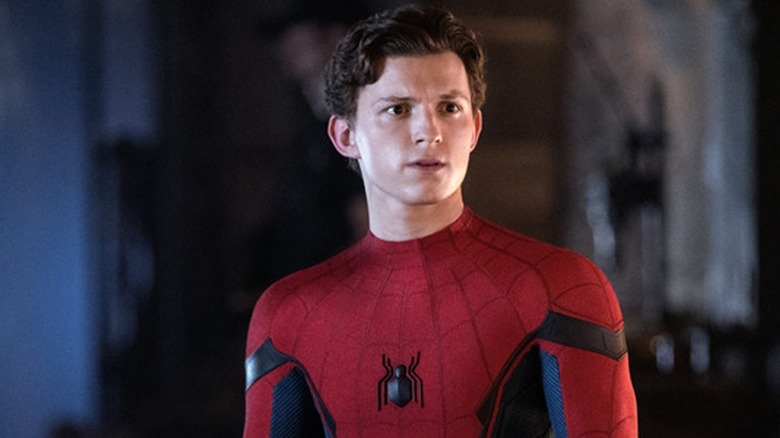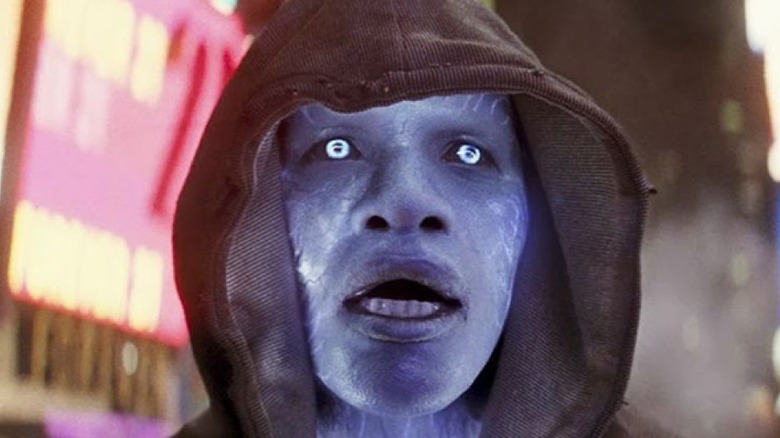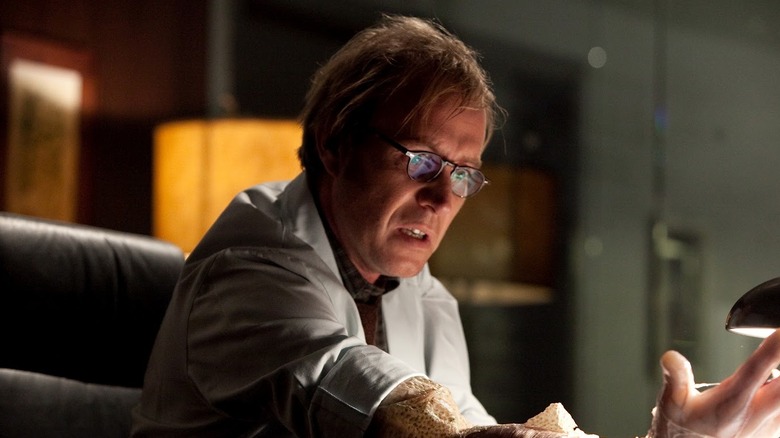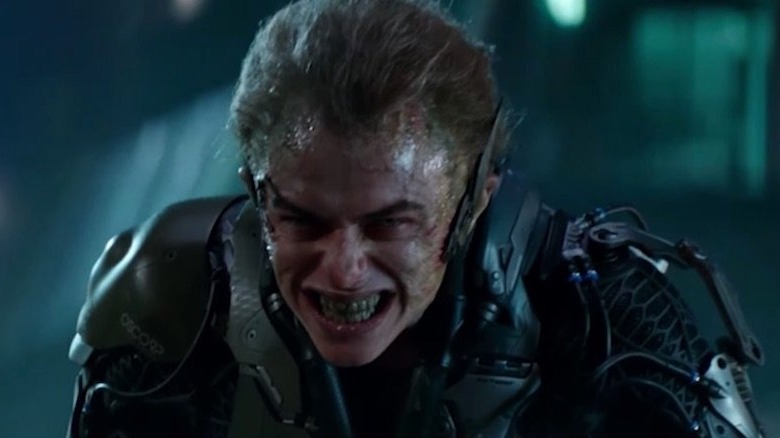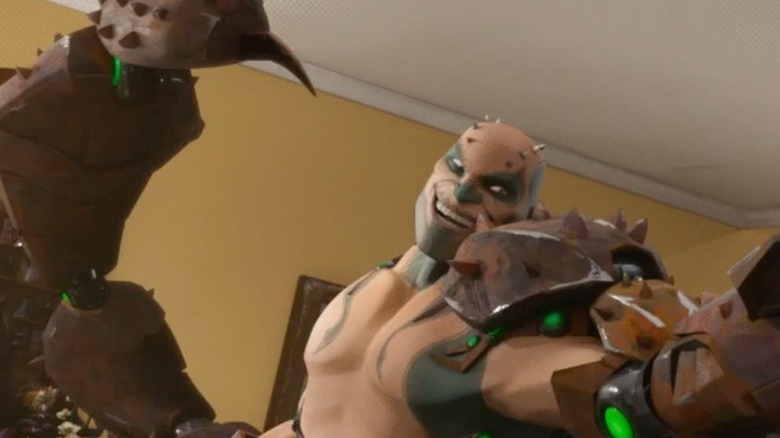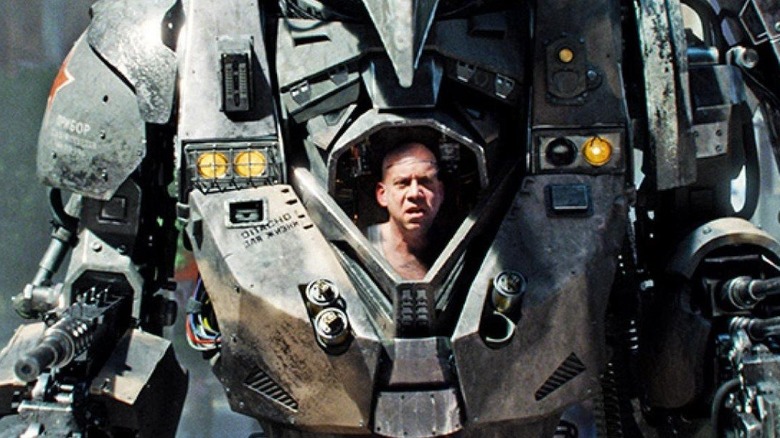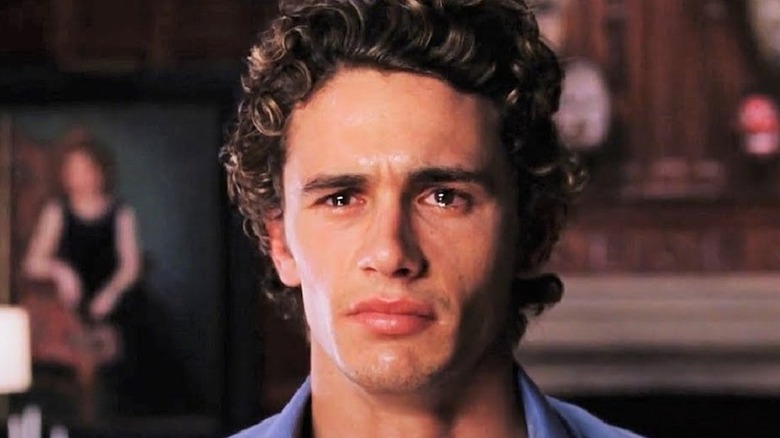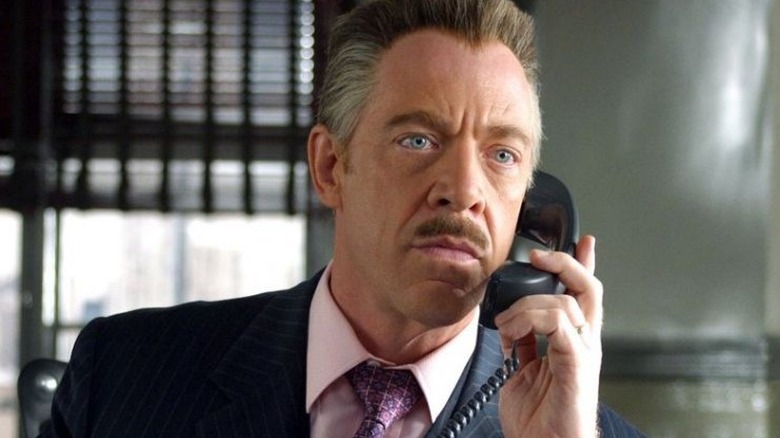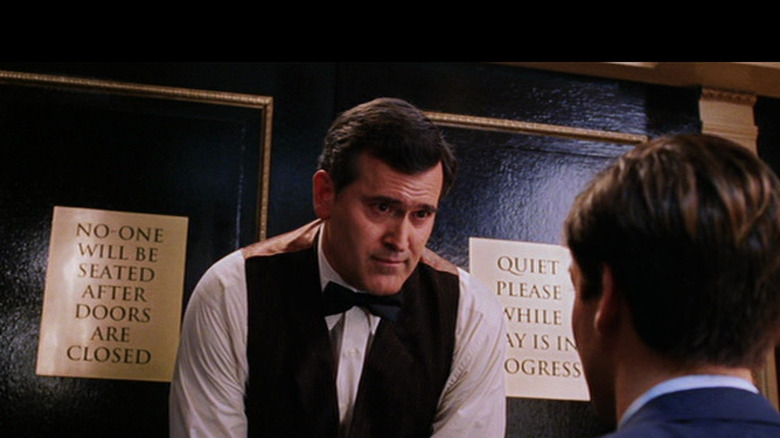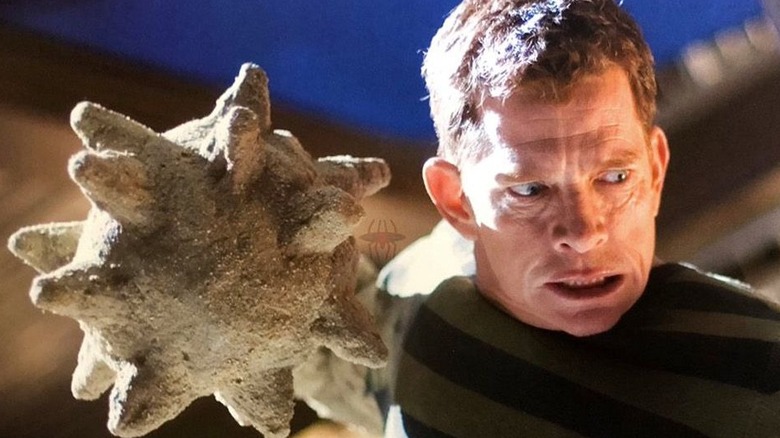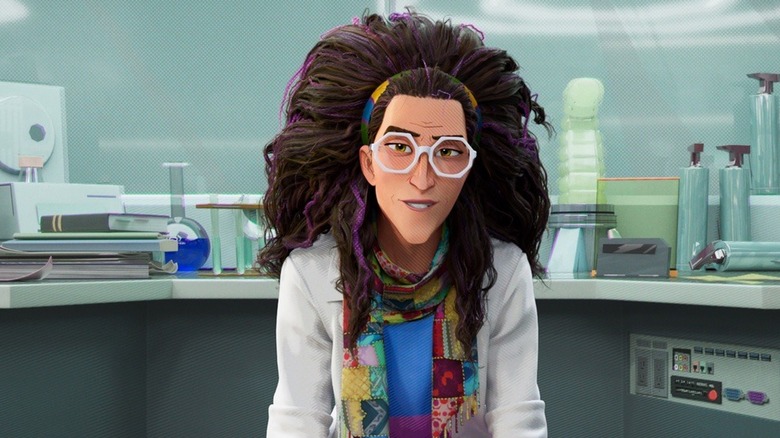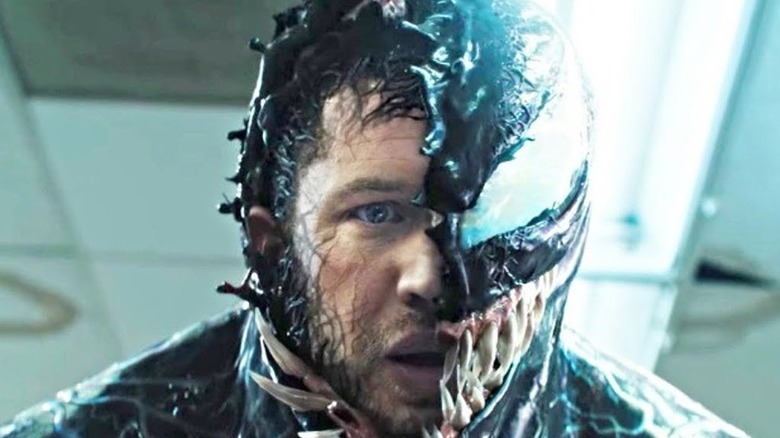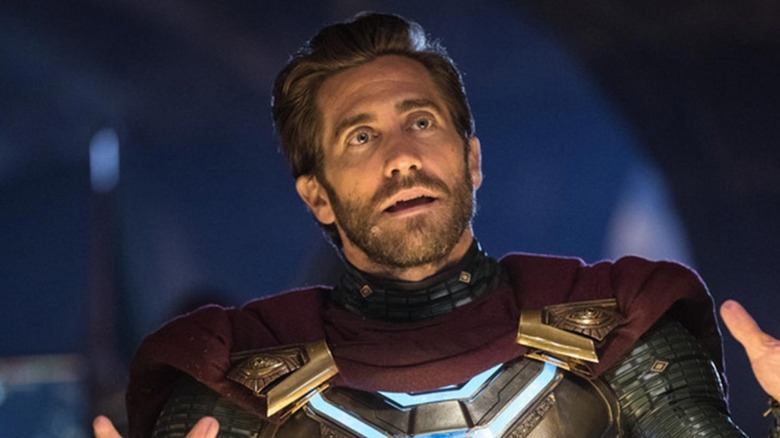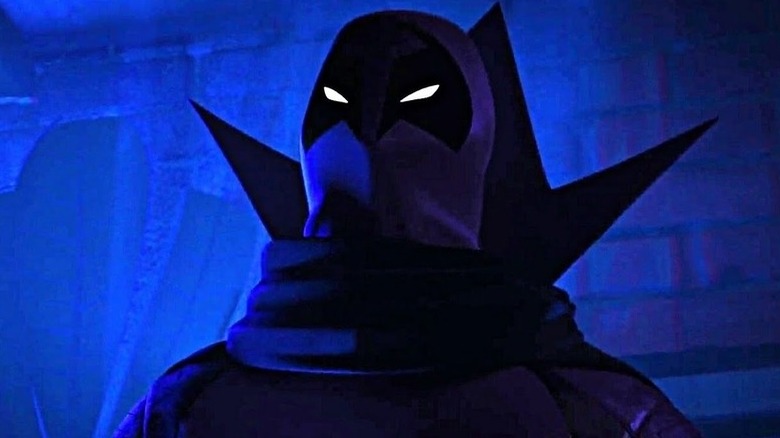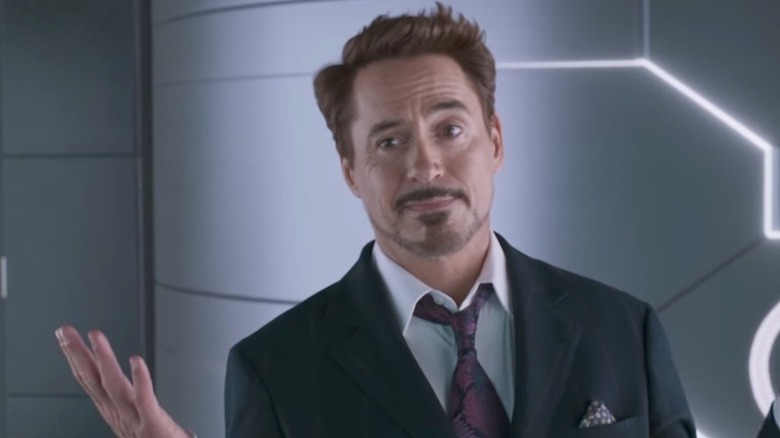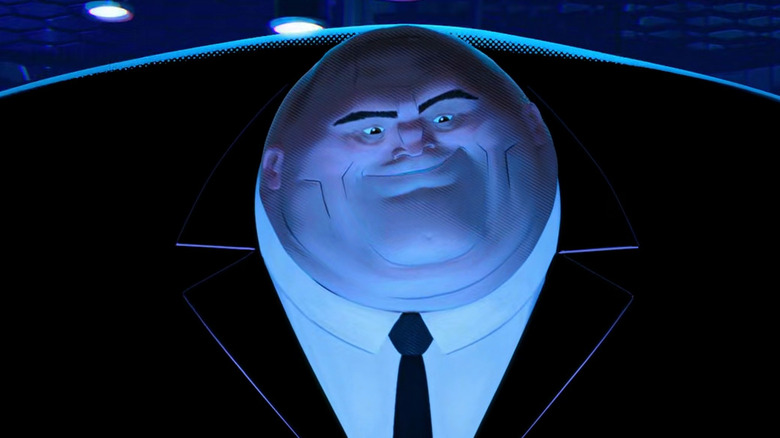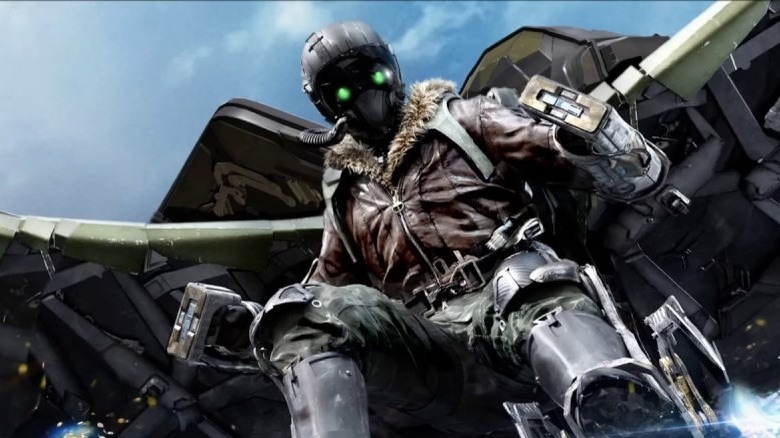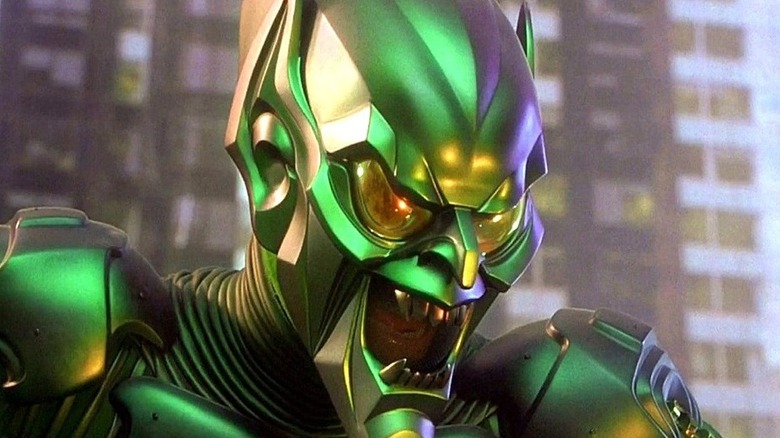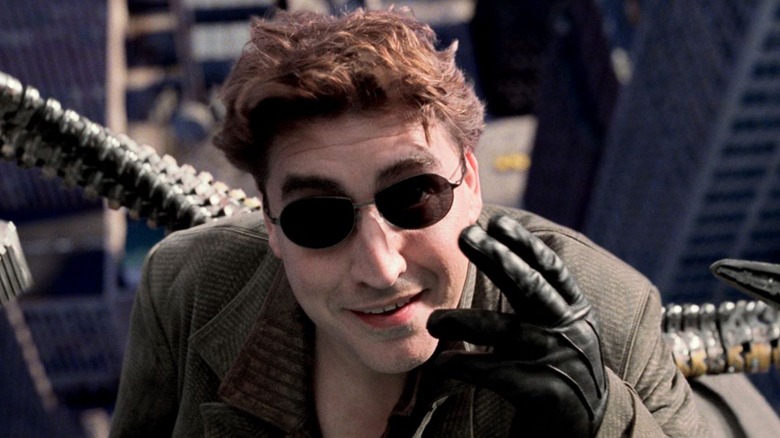The 15 Best Spider-Man Villains, Ranked
Merriam-Webster defines a rogues gallery as "a collection of pictures of persons arrested as criminals." Think "The Usual Suspects" poster. Think "Guardians of The Galaxy." Think, the many spectacular foes of Spider-Man. The web-headed wallcrawler has faced scores of bad guys since his inception in 1962, many of whom have captured audience's imaginations on both the page and silver screen.
Especially the silver screen.
Yes, there can be no doubt about it: The MCU and DCEU wouldn't have dominated the multiplex for decades if Sam Raimi's "Spider-Man" trilogy hadn't kicked off in 2002, and scores of films (from 2006's "Batman Begins" to 2019's "Shazam") would not have succeeded as well as they did without the blueprint laid out by that trilogy's villains. These characters are parts of comic book movie history, and offer the best model for multiple blockbusters yet to come. Let us give them their due ... by ranking them.
19) Electro
Many actors have stoked anticipation for their roles in comic book movies. Kumail Nanjiani and Chris Pratt did so by transforming their bodies. Ryan Reynolds recited the Green Lantern oath at Comic-Con. And Jamie Foxx (checks notes) sang "The Itsy Bitsy Spider" on the red carpet. No, really.
This was the moment, in retrospect, when audiences should've known that both Foxx and director Marc Webb had failed to capture lightning in a bottle with their take on Electro. The primary villain of 2012's "The Amazing Spider-Man 2," Electro — aka Max Dillon — is presented as an Edward Nygma retread. He's a bullied but brilliant scientist, transformed via reckless experiment. The class conflicts which inform Dillon's comic book portrayal are completely absent, paving the way for a reliance on ineffective visual effects and the "creepy" intoning of nursery rhymes.
Simply put, it's a disappointment. This is ironic, because Max Dillon, as frequently realized by Stan Lee and Steve Ditko, was a disappointment to himself. Few villains, much less Spider-Man rogues, loathe themselves as much as Electro. That hatred makes him vulgar, even sorrowful. It makes him far more interesting than a template for ill-advised improvisation and upgraded costumes that only led to meme-based takedowns. Electro is the weakest on-screen Spider-Man villain, but embracing Max Dillon's canonized weakness might change that distinction rapidly.
18) Lizard
The story of Dr. Curt Connors (aka The Lizard) deserves time to breathe. It must show us the academic yet paternal relationship between Connors and Peter Parker, and it must make us care for Connors beyond his wartime amputation (anything less would feel cheap). On top of all that, it must also find time to both reveal and then make threatening the feral and anthropomorphic creature Connors becomes when his experiments go wrong. Connors is ostensibly a Universal movie monster in a comic-book universe. The issue with his portrayal in "The Amazing Spider-Man" is that Marc Webb favors the latter over the former.
To the movie's credit, there are moments during "The Amazing Spider-Man" where both the CGI Lizard and Rhys Ifans' portrayal of Curt Connors come close to the frightening or tragic depths (respectively) that the great Universal monsters inspired in their heyday. But by and large, those moments are absent. It's ironic that when Webb's first Spider-Man film was released, many were quick to highlight and praise its breathless dialogue, but Curt Connors and his story needed the air the (admittedly great) banter Peter Parker and Gwen Stacy was busy inhaling (To be fair, Dylan Baker's Curt Conners, seen in "Spider-Man 2," barely gets any airtime, either). Maybe next time.
17) New Goblin
You'll notice that the "worst" villains on this list come from Marc Webb's "Spider-Man" movies. I feel bad about this. I feel that critiquing them, however appropriate it might be to do so, is really a matter of picking low-hanging fruit. So let's attempt to give them a bit more credit than I have up until now: New Goblin works on paper.
Oof. That hurt to write, but I'll stand by it! Though "The Amazing Spider-Man 2" moves too fast for its own good, there's an argument to be made that its breakneck pace is thematically sound and achieved so that the sudden (spoiler alert) death of Gwen Stacy lands hard. To that end, why shouldn't Harry Osborne go from disgruntled rich kid to madman in two hours' time? See, it works!
So what doesn't? Sadly, Dane DeHann. To be clear, DeHann is a terrific actor with a bottomless well of talent and deft access to it. But Hollywood doesn't always know what to do with Dane DeHann. He felt miscast in Quibi's "The Stranger" and "Valerian and the City of a Thousand Planets," and he again feels miscast here. The brooding anger which made him compelling in "Chronicle" simply doesn't jibe with the razor's edge madness required for Goblin, and "The Amazing Spider-Man 2" stalls out as a result. It's more "swing and a miss" than simple miscalculation (which is an improvement on both Electro and The Lizard), but it's a miss all the same.
16 & 15) Tombstone & Scorpion
The discrepancy between a villain's appearance and overall effectiveness can be gargantuan. Case in point: Tombstone and Scorpion. Both minor heavies in the tremendous "Spider-Man: Into The Spider-Verse," the characters are impeccably realized by directors Peter Ramsey, Bob Persichetti, Randy Rothman, and the entire animation team. Tombstone is sleek yet ghostly, an obelisk in million-dollar threads. Scorpion, by contrast, is an earth-toned skirmish tank. His tail's spikes have spikes. Any child, long-time comic-book fan, or devotee of great animation will never forget Tombstone or Scorpion on the basis of looks alone.
Unfortunately, neither character has a tremendous amount to do in "Into The Spider-Verse," hence their lower placement on this list. Of the two, Scorpion gets an edge simply because his third-act confrontation with Spider-Ham ranks as one of the more side-splitting yet awesome moments committed to celluloid this century. But both are sterling proof that creative, care-filled visualization can tell a great story in abbreviated time.
14) Paul Giamatti's "Rhino"
I've referred to this character as Paul Giamatti's "Rhino" in the title heading because whatever made it to screen in "The Amazing Spider-Man 2" is not, I'm thrilled to report, Marvel Comics' Rhino. It is a character pulled so deep from Giamatti's id that it was probably a background actor in 2009's "Cold Souls." It is a performance so scenery-chewing that Giamatti probably needed to follow it with his naturalistic work in 2014's "Madame Bovary" as a dietary restriction.
This all feels very glib, and yet the tonal balance Giamatti and Webb strike at the beginning of "TASM 2" is the best version of that movie. It doesn't approach the baroque-yet-campy highs of Raimi's efforts, but it delivers an endearing version of a villain few know and some love. At no point does Rhino distract from Peter and MJ's narrative; he's a tremendous addition, and one the movie doesn't have to go out of its way to balance. That's all very different than the bloated, inconsistent mess that "Amazing Spider-Man 2" becomes the longer it goes on. Paul Giamatti's Rhino is the best of Marc Webb's movies. Bring him back for "No Way Home."
13) Green Goblin Jr.
At the risk of being self-aggrandizing: I'm very proud of a tweet I made in response to Tom Holland saying the "Spider-Man: No Way Home" trailer is just the tip of the iceberg where the movie's heroes and villains reveals are concerned. I mention this not to brag, but to tee up a response to it that really got me thinking. That response? " You people keep this up and you'll get James Franco. You don't WANT James Franco, DO YOU?"
To be absolutely clear: we do not want James Franco to be hired for new Spider-Man projects.
Franco's work as Harry Osbourne, which culminated in him becoming Green Goblin Jr. during "Spider-Man 3," has significantly depreciated in value since 2007, due to both allegations made against the actor and the Sam Raimi trilogy of "Spider-Man" movies exiting the zeitgeist. So let's roll it back for a moment: While Franco was a disappointment as Green Goblin Jr. — one unable to convey the role's necessary menace or carry the emotional weight of the movie's third act — he was a compelling and charming Harry Osbourne on three separate showings. Whoever plays Osbourne next will have those shoes to fill and, on the basis of scenes like this, they're larger than you might remember.
12) Capitalism & Classism
An examination of how capitalism and classism are subtextual villains in both Spider-Man's original origin story and modern-day Spider-Man movies could fill a separate essay.
So, instead, here are some facts in brief: Uncle Ben doesn't die if Peter Parker's paid in full. Adrian Toomes is bought out by a higher bidder. Aunt May is behind on bills. Spider-Man's villains rarely want to watch the world burn so much as punish capitalist society for thwarting their progress or making them literal monsters; and the working class is seen in Spider-Man films as either being plagued by greed or rising up to defend their big-shot little guy, your friendly neighborhood Spider-Man.
Capitalism and classism don't toss bombs at parades, nor do they cause havoc through the multiverse. But they do hang over Spider-Man movies, and have made monsters of many. Both absolutely belong on this list.
11) Sony Pictures
What are the core tenets of a villain? According to the Oxford English Dictionary, they are "A person or animal of a troublesome character in some respect." Sony Pictures is not a person or animal; they are a corporation. But if corporate personhood is a defensible term in court (and, oh, it is), then corporations are people — which means it is possible for Sony to be one of Spider-Man's latest and greatest villains. I would argue that they are.
Sony Pictures, like Wilson Fisk before it, sees itself as the benevolent shepherd of a thing both real and mythic — for Fisk, it is New York City; for Sony, it is Peter Parker. But where Fisk often turned to violence as a means to make his ends, Sony has ... well, they just dropped the ball. The Marc Webb movies are a ball drop. The PR battle over Tom Holland's "Spider-Man" is a ball drop. And it was Sony who, like Fisk, decided they knew what was best for Spider-Man and thrust Venom into "Spider-Man 3," a character director Sam Raimi held little love for.
Both Fisk and Sony scored their victories from time to time (in Sony's case, "Into The Spider-Verse" was an absolute masterstroke of filmmaking), but those wins have been soured by legal battles, questionable choices, and who knows what else. Sony doesn't see itself as a villain. Most villains don't. You be the judge as to what their role is here.
10) Sandman
Sandman is the broken heart of "Spider-Man 3," a man whose happiness has been slipping through his fingers, grain-like, for far too long. Time has been cruel to him. When Sandman (aka William Baker) says "I've made some bad decisions," he means scores of them. When he scowls, it's the closest he'll ever come to smiling.
In a vacuum, Sandman is a very good Spider-Man movie villain. And as played by Thomas Haden Church, he is human yet epic and heartbreaking (Hayden Church was coming off his career-best role in "Sideways" here, and it shows; he's incredible).
The fault, dear reader, is not in Sandman's star, but in his movie. I hinted earlier that "Spider-Man 3" is a mess even Sam Raimi can't get behind. It's both better and worse than that. It fails to tell any of its villains' stories fully because it's equally committed to all of them (it even briefly makes Peter the villain). It passes the ball but never moves it far downfield — so as the movie sputters to an end, so too, sadly, does Sandman. There's hope Sandman will get some redemption in the forthcoming "Spider Man: No Way Home." It's slim, and not the kind William Baker would cling to ... but I want to, anyway.
9) Olivia Octavius
In the year 2021, it's difficult to imagine being surprised that Kathryn Hahn was playing villains. Hahn is Agatha Harkness now — the TV show manipulating, spin-off getting, Emmy-nominated, bop-having witch and antagonist of Disney+'s smash hit "WandaVision." Things were different back in 2018, and the reveal in "Spider-Man: Into The Spider-Verse," that the quirky scientist voiced by Hahn was none other than Dr. Olivia Octavius, made audiences shriek and heads spin.
Revisiting "Into The Spider-Verse," it's incredible to see how much more substantial the character of Liv Octavius is beyond that twist. Though she occupies the screen for far less time than her male, live-action counterpart, it is amply clear that Liv Octavius loves science. Her passion for it bubbles over and out of her, is rendered fizzy enough to serve as a neat misdirection but also an inspiration for Miles and his entire high-school class.
Watching that passion give way to menace, however, is one of the movie's more bone-chilling moments. In both instances, Hahn's vocal work is elastic, memorable, and as deeply funny as the comedic performances that made her beloved by so many on film Twitter. Liv Octavius is to "Spider-Verse" what Kathryn Hahn has been to Hollywood for decades-plus — its secret weapon.
8) Venom
The story of Venom is a tale of two cities — New York and San Francisco. In New York ("Spider-Man 3"), Venom is a vengeful, murderous villain hellbent on killing Peter Parker. On the opposite coast, Venom is in a codependent relationship with Eddie Brock, crashes Pride rallies, and raises two pet chickens. The former is the worst of times; the latter is ... better?
Yes. It's totally better.
Let's be honest: when Tom Hardy hopped into a lobster tank, Venom's on-screen trajectory changed. Instead of being the next action franchise sensation Sony hoped him to be, Venom instead became a bastion for gothic comedy in 2021's "Venom: Let There Be Carnage," a film that was equal parts ridiculous and in on the gag. It proved a popular approach both at the box-office and on Twitter.
And if the film's ecstatically received post-credits scene is any indication, audiences are ready for this particular Venom — lovelorn, petty, and anti-heroic — to terrorize young Tom Holland in the very near future. Will returning to New York prove more fruitful for Eddie Brock than it was in 2007? Or are he and Venom best left on the Best Coast? If Tom Hardy's Instagram is any indication, we'll find out sooner rather than later.
7) Mysterio
The MCU is known for many things — dashing heroes, whip-fast quips, a moment worth staying through the credits for — but "visual splendor" isn't one of them. This has been written and spoken about ad-nauseam, but bears repeating here because Quentin Beck (aka Mysterio) is a villain whose whole bag is visuals. And if the team behind "Spider-Man: Far From Home" was going to bring Beck to screen successfully, they would have to make the MCU more cinematically resplendent than it had been to date. I am thrilled to say they did.
One scene doesn't make a good Spider-Man villain, to be sure, but the sequence in which Mysterio breaks Spider-Man's mind is one of the MCU's best, a hallucinogenic nightmare hall in which taut psychology tangos with franchise tentpole cinema. It also reveals the heart of MCU Mysterio. As realized by writers Chris McKenna and Erik Sommers (plus director Jon Watts), Quentin Beck is one of many beleaguered geniuses who make Tony Stark seem smarter. He is a CGI artist, a burnt-out animator, and he slyly acts as a proxy for the hundreds of people who make Marvel movies the spectacle they are. That makes him compelling. So does noted scarf owner Jack Gyllenhaal, who makes Beck both a vehicle for and subversion of his matinee idol looks.
Lastly, Mysterio — not Vulture, Doc Ock, Green Goblin, anyone — is the villain who exposes Spider-Man's identity to the world. That's something worth being known for, and it ensures Mysterio will be remembered among Spidey's best on-screen bad guys.
6) Prowler
It's fair to assume that villains despise heroes; we're often told as much. The tremendous "Batman: The Animated Series" episode "Almost Got 'Em" hinges on this notion — that a bad guy's downtime is occupied by collective hatred for and frustration caused by do-gooders, that their pride is fixed to wrongdoing. Prowler takes no pride in the crimes he commits.
The character — who appears in 2018's "Spider-Man: Into The Spider-Verse" — is a gun for hire whose pride has been scattered to the wind. When his costume comes off and everyday life takes over, it turns out Prowler is just Uncle Aaron, an ordinary guy who's a hero to his nephew, Miles Morales. Prowler is one of two characters in the Spider-Man movie universe (more on the other later) who illustrates how complicated it is to be a good and bad guy simultaneously.
So, yes: sometimes villains don't despise heroes. Sometimes fighting heroes is just the job, even when they're your kin. And sometimes, as Prowler brilliantly and tragically proves, the only way to be proud of your villainy is by getting out of it for good — one way or another.
5) The Hubris of Tony Stark
Full disclosure: My very talented co-worker Max Marriner pitched the outline for this article. In it, he had a villain listed which made my jaw drop — the hubris of Tony Stark. Max is 100% right, and I'd like to elaborate on why.
The MCU Tony Stark creates demons; we know this. He ignores Aldrich Killian's humanity in "Iron Man 3," his unnecessary buy-out of the GCT cleanup puts Adrian Toomes on the path to evil deeds in "Spider-Man: Homecoming," and his mistreatment of Quentin Beck almost causes the destruction of London in "Spider-Man: Far From Home." This is all very bad. What makes it worse? Tony Stark, for all intents and purposes, creates the Marvel Cinematic Universe's Spider-Man.
Yes, it is confirmed that Tom Holland's Peter Parker had an Uncle Ben and that his death led Peter to great power and responsibility. But consider this: two films in, Spider-Man is still using that power to clean up Tony Stark's messes, even from beyond the grave. His entire hero's journey — from the call to action to multiple passes through the abyss — exists and is still framed by genius playboy philanthropist behavior. Tony Stark already had a Damage Control; he also had the hubris to turn an extraordinary teenage boy into another extension of it, to sift through the dangers that were afterthoughts in the dustiest corners of his mind.
That's not just hubris — it's despicable.
4) Kingpin
Kingpin is a larger-than-life villain; it's fitting that Michael Clark Duncan and Vincent Philip D'Onofrio — both towering human beings and personalities — brought him to life for two different versions of "Daredevil." It's also why Liev Schreiber (another skyscraper-sized force of an actor) voices him in "Spider-Man: Into The Spider-Verse." Kingpin is prone to massive bursts of violence, verbal tirades, and a thousand-yard stare that could crack the Earth's fault lines. What Kingpin isn't, usually, is sad. ut in "Into The Spider-Verse," Wilson Fisk is as sad as they come.
Of the many brilliant choices that "Spider-Verse" makes, one of the best is to highlight the idea that a man who'd make the greatest city in the world his empire might still find it wanting without love. New York is where dreams are made, where anything can happen. But even in the City That Never Sleeps, death can't be cheated. That Wilson Fisk — a man who has caused the deaths of thousands over the course of his criminal career — would be so shattered by loss as to seek the one thing from New York no place on the world could provide is devastating.
3) Vulture
Jon Watts makes movies about bad guys. His breakthrough effort, 2015's "Cop Car," is just as concerned (if not more so) with Kevin Bacon's corrupt Sherrif Kretzer as it is with its child protagonists. And on a purely technical level, there's an argument to be made that "Spider-Man: Homecoming" is just as much Vulture's story as Peter Parker's.
Consider: "Spider-Man: Homecoming" opens with Adrian Toomes (aka The Vulture) trying to maintain his dignity and honor in a world that's passing him by. The government seizes his city contract to salvage Grand Central; his house and family's well-being are at stake. Toomes then takes an understandable pivot towards wrong-doing by keeping the Chitari tech. "The world's changing," Toomes sneers. "It's time we change, too." Toomes sacrifices his honor for business and riches — how many times has Tony Stark done the same?
"Spider-Man: Homecoming" is explicitly aware of the fact that Stark and his scrupulous heroics are the reason Vulture exists, but it's also interested in who Vulture will be once Peter Parker's foils his plans. Later, the film's post-credit scene involves Toomes running into Mac Gargan (aka Scorpion) in prison, trying to determine if Toomes knows who Spider-Man is. Toomes, of course, does (as revealed in one of the all-time greatest MCU scenes). His response: "If I knew who he was, he'd already be dead." Toomes then walks towards his visiting family, honor restored.
This is why Vulture is a top three live-action Spider-Man villain. He's a complicated human who indulges his worst instincts despite his best intentions. When given great power he acts irresponsibly under the auspice of familial obligation. And, as played by Michael Keaton, he has more heart and soul than almost every MCU heavy put on screen to date. There might be too many bad guys in "Spider-Man: No Way Home," but Jon Watts' take on Vulture proves that all of them are in very good hands.
2) Green Goblin
The single most surprising part of Sam Raimi's "Spider Man" — a movie which features shocking camerawork, a Randy Savage cameo, and the one (kind of) bearable Chad Kroeger song — is three simple words: "Don't tell Harry." They are Norman Osborne's last. He is the Green Goblin, but above all else, Norman Osbourne is a father by blood to Harry and a father by proxy to Peter Parker, his erstwhile foe "The Amazing Spider-Man".
He's also the patriarchal figure of his corporation, OsCorp — one that he is ousted from, furthering his descent into madness. Green Goblin Marvel Comics' stories have, by their nature, tended to highlight Norman's role as the head of many households, but as highlighted by this iconic sequence, Raimi's "Spider-Man" reveals the dark heart of what siring can yield.
Resentment. Lashing out. The balm of others' pain. These are the meals that Green Goblin feasts on, as emphatically as he would carving a Thanksgiving turkey. But Raimi, his writing team, and the magnificent Willem Dafoe keep us wondering if Norman will choose a different diet right until the end. The push and pull between the two polarities of his personality (one Peter Parker experienced similarly in his own life on a smaller but no less ruinous scale) is the driving engine of the second half of "Spider-Man," and it brings the film to life with Hall of Fame-worthy muscle and verve.
This is really all to say: If Green Goblin isn't the all-time great on-screen villain he is, we don't get more Spider-Man movies. The proof is in the pudding and the proof, like all brilliant equations, is still capable of surprising.
1) Doc Ock
Otto Octavius is a victim of his own hubris and the very instincts which pushed him to become the world's greatest scientist. That hubris gets his wife killed, his experiment ruined, and four somewhat sentient robot arms fused to the base of his spine. It is the pursuit of greatness that breaks him.
Is that not terrifying?
We are taught, from a very young age, to strive for the highest level of ourselves, and superheroes — as fantastical as they may be — are presented as examples of what extraordinary excellence can look like. We are meant to see past the lab-created super strength and radioactive gamma rays and know that the heart of these super men and women make them great.
As presented in "Spider-Man 2," Otto Octavius does not have a corrupted heart; he merely encounters a moment of weakness. He's the equivalent of an all-star athlete who excels for years and misses the shot of his life when the game is on the line. "Spider-Man 2" understands this — it's why Otto is worthy of self-redemption — but that doesn't make the presentation any less chilling. "Spider-Man 2" and the incredible Alfred Molina understand that single moments of failure can make monsters of us all, if only if our minds, and that the power of those thoughts can manifest disastrous real-life consequences, inhibitor chip or no.
Doc Ock is a cautionary tale that transcends the mediums of comic-book or film. He is Spider-Man's greatest live-action villain.
